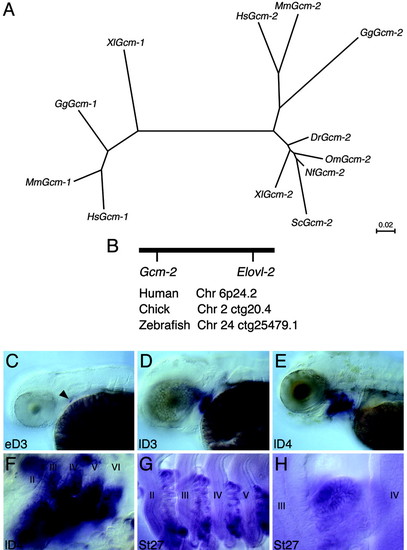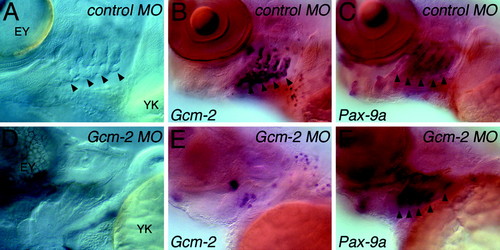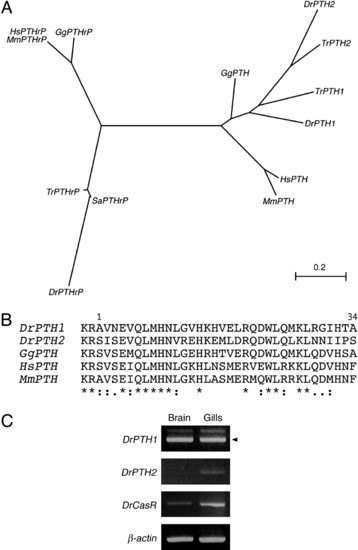- Title
-
The origin of the parathyroid gland
- Authors
- Okabe, M., and Graham, A.
- Source
- Full text @ Proc. Natl. Acad. Sci. USA
|
Phylogenetic analysis of the distribution of Gcm-2 and its expression in teleost (zebrafish) and chondrichthyan (dogfish) species. (A) A phylogenetic tree of vertebrate Gcm genes based on CLUSTAL analysis. Dr, zebrafish (Danio rerio); Gg, chicken (Gallus gallus); Hs, human (Homo sapiens); Mm, mouse (Mus musculus); Nf, Australian lungfish (Neoceratodus forsteri); Om, rainbow trout (Oncorhynchus mykiss); Sc, dogfish (Scyliorhinus canicula); Xl, Xenopus (Xenopus laevis). Branch lengths are in units of number of amino acid substitutions per site. (B) Schematic depicting the conserved linkage between Gcm2 and Elovl2 in humans on chromosome 6p24.2, in chickens on chromosome 2 ctg20.4, and in zebrafish on chromosome 24 ctg254791. (C–F) Gcm-2 expression in zebrafish embryos. In these micrographs, anterior is to the left and ventral is to the bottom. Gcm-2 initiates expression in the second pharyngeal pouch in early 3-day-old larval fish (indicated by arrowhead in C). Subsequently, Gcm-2 is expressed sequentially in the more posterior pouches (D), and, by day 4, Gcm-2 is expressed in all of the pouches (E). It is also apparent by day 4 that Gcm-2 is expressed in the developing internal gill buds emerging from the pharyngeal pouches (F). (G and H) Gcm-2 expression in dogfish embryos. This gene is expressed in the internal gill buds protruding from the pharyngeal pouches in stage-27 dogfish embryos (17). The pharyngeal arches are numbered II–VI. EXPRESSION / LABELING:
|
|
i>Gcm-2 is required for the elaboration of the internal gill buds from the pharyngeal pouches in zebrafish. Zebrafish embryos were injected at the one-cell stage with either control or antisense Gcm-2 MOs. The embryos were then analyzed at day 5 for the presence of internal gill buds. (A–C) Five-day-old zebrafish larva injected with control MO. (A) Nomarski view of the pharyngeal region of a day-5 embryo injected with the control MO. The internal gill buds protruding from the pharyngeal pouches are clearly evident (arrowheads). (B) Embryo injected with control MO hybridized for Gcm-2. Gcm-2-expressing internal gill buds can be clearly seen protruding from the pharyngeal pouches. (C) Embryo injected with control MO, showing normal pharyngeal pouch formation as judged by Pax-9a expression. Each pharyngeal pouch is indicated by an arrowhead. (D–F) Five-day-old zebrafish larva injected with Gcm-2 antisense MO. (D) Nomarski view of the pharyngeal region of a E5 embryo injected with the antisense Gcm-2 MO. There are no internal gill buds protruding from the pharyngeal pouches. (E) Embryo injected with the antisense Gcm-2 MO hybridized for Gcm-2. There are no Gcm-2-expressing internal gill buds protruding from the pharyngeal pouches. (F) Embryo injected with the antisense Gcm-2 MO, showing normal pharyngeal pouch formation as judged by Pax-9a expression. Each pharyngeal pouch is indicated by an arrowhead. EY, eye; YK, yolk. Anterior is to left and ventral is to the bottom. EXPRESSION / LABELING:
|
|
PTH genes in zebrafish. (A) A phylogenetic tree of PTH and PTHrP genes in vertebrates. Dr, zebrafish (Danio rerio); Gg, chicken (Gallus gallus); Hs, human (Homo sapiens); Mm, mouse (Mus musculus); Sa, seabream (Sparus aurata); Tr, fugu (Takifugu rubripes). (B) Comparison of the partial peptide sequences of zebrafish PTH and amniote PTH. The N-terminal 34 aa of mature human PTH peptide are sufficient for the biological activity of PTH. This alignment includes the N-terminal amino acids (1–34) with 2 aa before the final proteolytic cleavage site. (C) Gills in adult zebrafish express both the PTH genes and CasR. PTH and CasR were amplified from adult brain and gills by RT-PCR. Arrowhead indicates cDNA product. |



